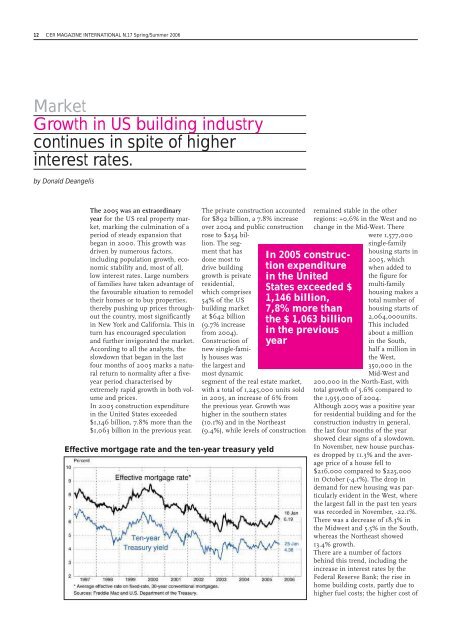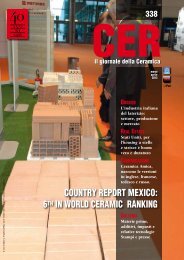Editorial - Pool.mo.it
Editorial - Pool.mo.it
Editorial - Pool.mo.it
Create successful ePaper yourself
Turn your PDF publications into a flip-book with our unique Google optimized e-Paper software.
12<br />
CER MAGAZINE INTERNATIONAL N.17 Spring/Summer 2006<br />
Market<br />
Growth in US building industry<br />
continues in sp<strong>it</strong>e of higher<br />
interest rates.<br />
by Donald Deangelis<br />
The 2005 was an extraordinary<br />
year for the US real property market,<br />
marking the culmination of a<br />
period of steady expansion that<br />
began in 2000. This growth was<br />
driven by numerous factors,<br />
including population growth, economic<br />
stabil<strong>it</strong>y and, <strong>mo</strong>st of all,<br />
low interest rates. Large numbers<br />
of families have taken advantage of<br />
the favourable s<strong>it</strong>uation to re<strong>mo</strong>del<br />
their homes or to buy properties,<br />
thereby pushing up prices throughout<br />
the country, <strong>mo</strong>st significantly<br />
in New York and California. This in<br />
turn has encouraged speculation<br />
and further invigorated the market.<br />
According to all the analysts, the<br />
slowdown that began in the last<br />
four <strong>mo</strong>nths of 2005 marks a natural<br />
return to normal<strong>it</strong>y after a fiveyear<br />
period characterised by<br />
extremely rapid growth in both volume<br />
and prices.<br />
In 2005 construction expend<strong>it</strong>ure<br />
in the Un<strong>it</strong>ed States exceeded<br />
$1,146 billion, 7.8% <strong>mo</strong>re than the<br />
$1,063 billion in the previous year.<br />
The private construction accounted<br />
for $892 billion, a 7.8% increase<br />
over 2004 and public construction<br />
rose to $254 billion.<br />
The seg-<br />
ment that has<br />
done <strong>mo</strong>st to<br />
drive building<br />
growth is private<br />
residential,<br />
which comprises<br />
54% of the US<br />
building market<br />
at $642 billion<br />
(9.7% increase<br />
from 2004).<br />
Construction of<br />
new single-family<br />
houses was<br />
the largest and<br />
<strong>mo</strong>st dynamic<br />
segment of the real estate market,<br />
w<strong>it</strong>h a total of 1,245,000 un<strong>it</strong>s sold<br />
in 2005, an increase of 6% from<br />
the previous year. Growth was<br />
higher in the southern states<br />
(10.1%) and in the Northeast<br />
(9.4%), while levels of construction<br />
Effective <strong>mo</strong>rtgage rate and the ten-year treasury yeld<br />
In 2005 construction<br />
expend<strong>it</strong>ure<br />
in the Un<strong>it</strong>ed<br />
States exceeded $<br />
1,146 billion,<br />
7,8% <strong>mo</strong>re than<br />
the $ 1,063 billion<br />
in the previous<br />
year<br />
remained stable in the other<br />
regions: +0,6% in the West and no<br />
change in the Mid-West. There<br />
were 1,577,000<br />
single-family<br />
housing starts in<br />
2005, which<br />
when added to<br />
the figure for<br />
multi-family<br />
housing makes a<br />
total number of<br />
housing starts of<br />
2,064,000un<strong>it</strong>s.<br />
This included<br />
about a million<br />
in the South,<br />
half a million in<br />
the West,<br />
350,000 in the<br />
Mid-West and<br />
200,000 in the North-East, w<strong>it</strong>h<br />
total growth of 5.6% compared to<br />
the 1,955,000 of 2004.<br />
Although 2005 was a pos<strong>it</strong>ive year<br />
for residential building and for the<br />
construction industry in general,<br />
the last four <strong>mo</strong>nths of the year<br />
showed clear signs of a slowdown.<br />
In November, new house purchases<br />
dropped by 11.3% and the average<br />
price of a house fell to<br />
$216,000 compared to $225,000<br />
in October (-4.1%). The drop in<br />
demand for new housing was particularly<br />
evident in the West, where<br />
the largest fall in the past ten years<br />
was recorded in November, -22.1%.<br />
There was a decrease of 18.3% in<br />
the Midwest and 5.5% in the South,<br />
whereas the Northeast showed<br />
13.4% growth.<br />
There are a number of factors<br />
behind this trend, including the<br />
increase in interest rates by the<br />
Federal Reserve Bank; the rise in<br />
home building costs, partly due to<br />
higher fuel costs; the higher cost of













